See also
- In typography, some forms of fleuron are also known as an "aldus leaf"
Aldus may refer to:

The Aldine Press was the printing office started by Aldus Manutius in 1494 in Venice, from which were issued the celebrated Aldine editions of the classics. The first book that was dated and printed under his name appeared in 1495.
Hack may refer to:

Palatino is an old-style serif typeface designed by Hermann Zapf, initially released in 1949 by the Stempel foundry and later by other companies, most notably the Mergenthaler Linotype Company. Palatino is optimised for legitibility with open counters, balanced proportions, moderate stroke contrast and flared serifs.

Aldus Corporation was an American software company best known for its pioneering desktop publishing software. PageMaker, the company's most well-known product, ushered in the modern era of desktop computers such as the Macintosh seeing widespread use in the publishing industry. Paul Brainerd, the company's co-founder, coined the term desktop publishing to describe this paradigm. The company also originated the Tag Image File Format (TIFF) file format, widely used in the digital graphics profession.

Aldus Pius Manutius was an Italian printer and humanist who founded the Aldine Press. Manutius devoted the later part of his life to publishing and disseminating rare texts. His interest in and preservation of Greek manuscripts mark him as an innovative publisher of his age dedicated to the editions he produced. Aldus Manutius introduced the small portable book format with his enchiridia, which revolutionized personal reading and are the predecessor of the modern paperback book. He also helped to standardize use of punctuation including the comma and the semicolon.

Garamond is a group of many serif typefaces, named for sixteenth-century Parisian engraver Claude Garamond, generally spelled as Garamont in his lifetime. Garamond-style typefaces are popular to this day and often used for book printing and body text.
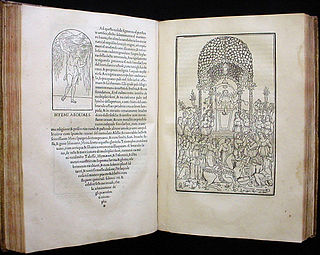
Hypnerotomachia Poliphili, called in English Poliphilo's Strife of Love in a Dream or The Dream of Poliphilus, is a book said to be by Francesco Colonna. It is a famous example of an incunable. The work was first published in 1499 in Venice by Aldus Manutius. This first edition has an elegant page layout, with refined woodcut illustrations in an Early Renaissance style. Hypnerotomachia Poliphili presents a mysterious arcane allegory in which the main protagonist, Poliphilo, pursues his love, Polia, through a dreamlike landscape. In the end, he is reconciled with her by the "Fountain of Venus".
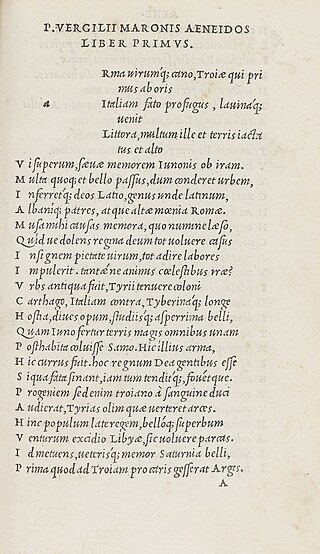
In typography, italic type is a cursive font based on a stylised form of calligraphic handwriting. Along with blackletter and roman type, it served as one of the major typefaces in the history of Western typography.
In typography, leading is the space between adjacent lines of type; the exact definition varies.
Aldine is an adjective pertaining to Renaissance printer Aldus Manutius, including the renowned publications and typography of the Aldine Press he founded in 1494.

Antiqua is a style of typeface used to mimic styles of handwriting or calligraphy common during the 15th and 16th centuries. Letters are designed to flow, and strokes connect together in a continuous fashion; in this way it is often contrasted with Fraktur-style typefaces where the individual strokes are broken apart. The two typefaces were used alongside each other in the Germanophone world, with the Antiqua–Fraktur dispute often dividing along ideological or political lines. After the mid-20th century, Fraktur fell out of favor and Antiqua-based typefaces became the official standard in Germany.

Roman square capitals, also called capitalis monumentalis, inscriptional capitals, elegant capitals and capitalis quadrata, are an ancient Roman form of writing, and the basis for modern capital letters. Square capitals are characterized by sharp, straight lines, supple curves, thick and thin strokes, angled stressing and incised serifs. When written in documents this style is known as Latin book hand.
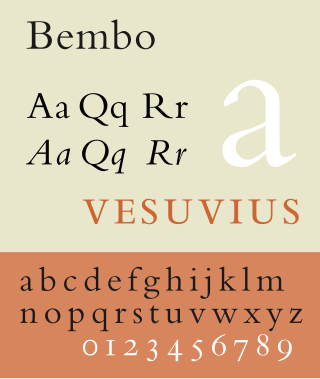
In Latin script typography, roman is one of the three main kinds of historical type, alongside blackletter and italic. Sometimes called normal or regular, it is distinct from these two for its upright style and its simplicity.
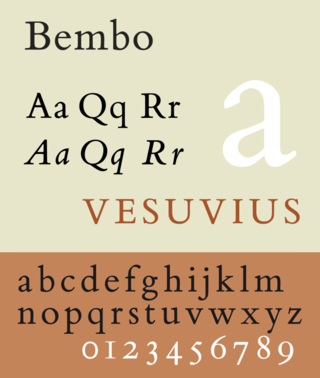
Bembo is a serif typeface created by the British branch of the Monotype Corporation in 1928–1929 and most commonly used for body text. It is a member of the "old-style" of serif fonts, with its regular or roman style based on a design cut around 1495 by Francesco Griffo for Venetian printer Aldus Manutius, sometimes generically called the "Aldine roman". Bembo is named after Manutius's first publication with it, a small 1496 book by the poet and cleric Pietro Bembo. The italic is based on work by Giovanni Antonio Tagliente, a calligrapher who worked as a printer in the 1520s, after the time of Manutius and Griffo.
Francesco Griffo (1450–1518), also called Francesco da Bologna, was a fifteenth-century Italian punchcutter. He worked for Aldus Manutius, designing the printer's more important humanist typefaces, including the first italic type. He cut Roman, Greek, Hebrew and the first italic type. Aldus gives Griffo credit in the introduction of the Virgil of 1501. However, as Manutius had achieved a monopoly on italic printing and Greek publishing with the permission of the Venetian government, he had a falling-out with Griffo. Griffo then went to work for Gershom Soncino, whose family were Hebrew printers. It was with Soncino that Griffo's second italic type was cut in 1503. In 1516 he returned to Bologna where he began print publishing. In 1518 Griffo was charged with the murder of his son-in-law, who had been beaten to death with an iron bar. This is his last appearance in the historical record. He is presumed to have been executed.
Aldus Manutius, the Younger was the grandson of Aldus Manutius and son of Paulus Manutius. He was the last member of the Manuzio family to be active in the Aldine Press that his grandfather founded.

Yale is an old style serif typeface designed by Matthew Carter and first released in 2004. It was commissioned by Yale University for use in all of its signage, promotional and internal material.
Scala or SCALA may refer to:
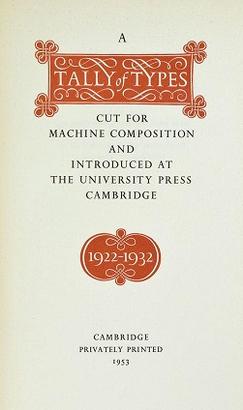
A Tally of Types is a book on typography authored by the type designer Stanley Morison. It was first published in 1953, and showcases significant typeface designs produced during Morison's tenure at the Lanston Monotype Corporation for their hot-metal typesetting machines during the 1920s and 1930s in England.
Johannes M. P. Knoops is an American architect, international architectural correspondent, and Professor in the Department of Interior Design at the Fashion Institute of Technology / State University of New York in New York City. Knoops' design for a private study in the tradition of a Japanese scholar's study as influenced by origami was written about in New York Magazine and his design for a new wedding chapel atop the New York Municipal Building by Architectural Scholar.